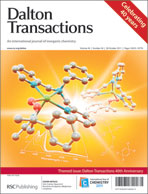The reaction of the ynediamine 1,2-dipiperidinoacetylene (1) with [(η2-COE)Cr(CO)5], [(THF)W(CO)5] and [RuCl2(η6-cymene)]2 afforded homobimetallic complexes 2a, 2b and 3, in which the diaminoacetylene 1 acts as a bis(aminocarbene) ligand by bridging two complex fragments Cr(CO)5 (in 2a), W(CO)5 (in 2b) and RuCl2(η6-cymene) (in 3). The reaction of 1 with [RuCl2(PPh3)3] gave trans-[(1)RuCl(PPh3)2]Cl, [4]Cl, in which the alkyne 1 coordinates as a 4-electron donor ligand. The cation 4 represents a rare example of a square-planar Ru(II) complex with a low-spin ground state (S = 0), and its stability can be ascribed to the strong alkyne-metal π-interaction as confirmed by DFT calculations. Treatment with one or two equivalents of NaBPh4 in acetonitrile gave [4]BPh4 and the dicationic [(1)Ru(PPh3)2(CH3CN)2](BPh4)2, [5](BPh4)2. [4]Cl can be used for the preparation of heterobimetallic Ru-Pd bis(aminocarbene) complexes by reaction with [(MeCN)2PdCl2], resulting in the formation of bimetallic 6 and tetrametallic 7.

You have access to this article
 Please wait while we load your content...
Something went wrong. Try again?
Please wait while we load your content...
Something went wrong. Try again?


 Please wait while we load your content...
Please wait while we load your content...